 |
 |
 |
 |
 |
 |
| |
 |
|
 |
 |
 |
  |
  |
 |
 |
 |
 |
|
|
 |
|
 |
 |
 |
BUILDING |
 |
|
 |
|
 |
 |
 |
| |
 |
| 
 |
Labirinto della Masone
The Masone Labyrinth |
|
 |
 |
 |
 |
DESIGNER |
 |
|
|
 |
|
 |
 |
 |
| |
 |
|
 |
 |
 |
 |
CONTEXT |
 |
|
|
 |
|
 |
 |
 |
| Location |
 |
|
 |
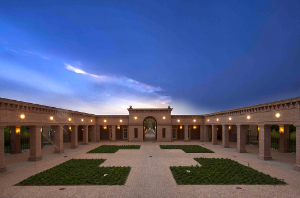 The labyrinth is at Fontanellato, Parma, a village full of history. The bamboo labyrinth should be considered as a legacy to that strip of the Po Valley including Parma, its countryside and the nearby towns, which Ricci has been tied to since birth and whose importance for art and the Italian landscape is often undervalued. Parma has always been a place of delights, the cradle of large, precious art collections. The labyrinth is at Fontanellato, Parma, a village full of history. The bamboo labyrinth should be considered as a legacy to that strip of the Po Valley including Parma, its countryside and the nearby towns, which Ricci has been tied to since birth and whose importance for art and the Italian landscape is often undervalued. Parma has always been a place of delights, the cradle of large, precious art collections.
Fontanellato, with its splendid historic centre, the Rocca Sanvitale and Parmigianino’s frescoes, contains an extraordinary artistic heritage and is also well-known for good food. Ricci is fascinated not only by the vicinity to a place so full of beauty but also the fondness for Fontanellato’s rural nature, specifically the Masone estate, which has been in his family for generations. |
|
 |
 |
 |
|
 |
|
| Overview |
 |
|
 |
|
 |
 |
 |
 |
 |
 |
 |
DESCRIPTION |
 |
|
|
 |
|
 |
 |
 |
| . |
 |
|
 |
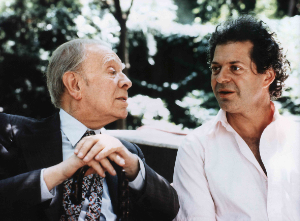 The largest labyrinth in the world was created at Fontanellato from an idea of Franco Maria Ricci, publisher, designer, art collector and bibliophile, and a promise he made in 1977 to the Argentinian writer Jorge Luis Borges, who had always been fascinated by the symbol of the labyrinth, also as a metaphor of the human condition. The largest labyrinth in the world was created at Fontanellato from an idea of Franco Maria Ricci, publisher, designer, art collector and bibliophile, and a promise he made in 1977 to the Argentinian writer Jorge Luis Borges, who had always been fascinated by the symbol of the labyrinth, also as a metaphor of the human condition.
There are labyrinths with Minotaurs. And gardens full of delights. Edens where wandering is wonderful, mental labyrinths where you can lose and then find yourself.
That of Ricci, an aesthete of sublime taste who has always been a lover of beauty, is an elegant, enticing maze. A place of culture, extending over eight hectares (80,000 sq. metres) of land, designed by him with the architects Pier Carlo Bontempi, who completed the surprising buildings, and Davide Dutto, who planned the geometry of the park. |
|
 |
 |
 |
|
 |
|
| A unique place from every point of view |
 |
|
 |
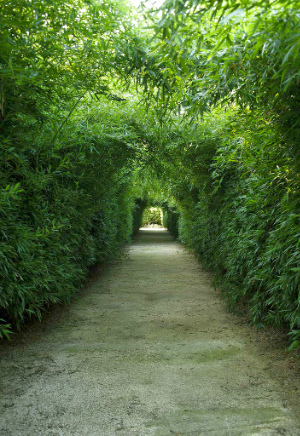 The labyrinth is an original place of many shapes, starting from the architecture of the whole project. There are three forms of classic labyrinth - the Cretan one with seven spirals, the Roman labyrinth with right angles and divided into quarters (four inter-communicating labyrinths), and the Christian labyrinth with 11 spirals, of the Chartres type. Ricci chose inspiration from the second one, nevertheless reworking it and introducing little traps here and there - junctions and blind alleys which there weren’t in the strictly unicursal (single-path) Roman labyrinths. The perimeter is star-shaped, a form which appears for the first time in Filarete’s Treatise on Architecture and was subsequently adopted by Vespasiano Gonzaga in Sabbioneta and the Venetian Republic at Palmanova in Friuli. The maze project underwent a long elaboration with the architect Davide Dutto who had edited a volume with the virtual reconstructions of Poliphilo’s Garden for Franco Maria Ricci. The labyrinth is an original place of many shapes, starting from the architecture of the whole project. There are three forms of classic labyrinth - the Cretan one with seven spirals, the Roman labyrinth with right angles and divided into quarters (four inter-communicating labyrinths), and the Christian labyrinth with 11 spirals, of the Chartres type. Ricci chose inspiration from the second one, nevertheless reworking it and introducing little traps here and there - junctions and blind alleys which there weren’t in the strictly unicursal (single-path) Roman labyrinths. The perimeter is star-shaped, a form which appears for the first time in Filarete’s Treatise on Architecture and was subsequently adopted by Vespasiano Gonzaga in Sabbioneta and the Venetian Republic at Palmanova in Friuli. The maze project underwent a long elaboration with the architect Davide Dutto who had edited a volume with the virtual reconstructions of Poliphilo’s Garden for Franco Maria Ricci.
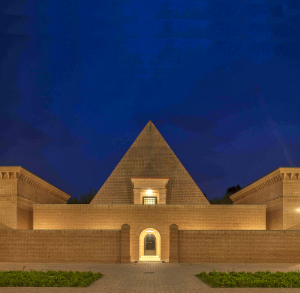 There is also a pyramid-shaped chapel inside the maze, a commemoration of the ancient link between mazes and faith. A labyrinth as a continuous reference between exterior and interior is depicted on the floor of this building and ceremonies can also be held there. There is also a pyramid-shaped chapel inside the maze, a commemoration of the ancient link between mazes and faith. A labyrinth as a continuous reference between exterior and interior is depicted on the floor of this building and ceremonies can also be held there.
The Masone maze appears as a highly original place of culture:
- it pays special attention to botany;
- it is a unique cultural asset through the library and the museum;
- it is an open atelier, seeing that it houses the head office of the publisher Franco Maria Ricci;
- it doesn’t forget either the outstanding local and national gastronomic pre-eminences, valorised by the very high quality catering spaces.
In addition to a unique experience offered by entering the thousand passages of the maze, Ricci also thought of creating collateral structures that confirm its nature as an ideal place for leisure time:
-
The restaurant will be for those who want to lunch elegantly, respecting tradition. Ricci’s love for the classic is not belied even at table. The base of the menu will be traditional Parma and Italian cuisine, developed and created by the well-known Spigaroli Brothers, Michelin-starred chefs.
- The bistro-café has been designed for those who want to rest for a moment during the visit. A quick, but excellent lunch can be taken seated under the porticos.
- The suites,consisting of two luxurious apartment finished with decorations of works of art and elegant furnishings, are at the heart of the labyrinth. They have one bedroom and two large bathrooms and are intended for guests of honour arriving from afar and lovers of total comfort.
|
|
 |
 |
 |
|
 |
|
| . |
 |
|
 |
|
 |
 |
 |
 |
 |
 |
 |
POINTS OF VIEW |
 |
|
|
 |
|
 |
 |
 |
| |
 |
Bamboo
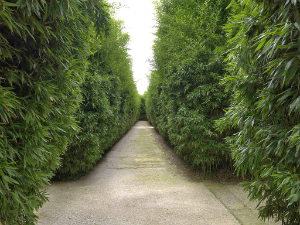 Bamboo is an elegant, sinuous, evergreen plant of great vigour, as shown by the rapidity of its growth. The varieties can be a few centimetres tall or reach considerable sizes. The real strength of bamboo is the high level of photosynthesis which reduces atmospheric carbon dioxide, restoring considerable quantities of oxygen.
“There was a sort of hortus conclusus,a small garden surrounded by high walls behind my house in Milan. At the beginning, I didn’t know what to do with it then, one day, a competent and polite Japanese gardener suggested planting a bamboo wood there. I took his advice.
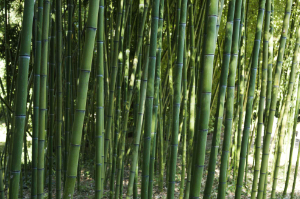 In Italy, bamboo is a little known, little-used plant; at the most, something is known about a single species, Phyllostachys aurea,often confused with reeds.
It’s a pity because it’s an extraordinary plant which doesn’t become diseased, doesn’t drop its leaves in winter, purifies the air of carbon dioxide as per the Kyoto Protocol and doesn’t causes disasters in the event of typhoons and tornadoes (nobody has ever died because a bamboo stem fell on them); in addition, its elegance is no less classic and impeccable than Bodoni characters. I went to France to buy the few bamboos necessary and there I discovered a wonderful place - the Bambouseraie d’Anduze.It’s a nursery and also a frequently-visited park; it was founded in the middle of the 19th century and houses about 200 different species of bamboo, some reaching 15 metres in height, others no more than half a metre. It’s the largest plantation in Europe. Perhaps there isn’t anything like it even in the East. The bamboo immediately grew lushly in my Milanese garden until it was taller than the walls surrounding it, resulting in some ill-feeling from the neighbours.
I was falling in love with the plant. I went back to the Bambouseraie and, this time, my purchases were enormous. I had decided to plant a bamboo garden on the land surrounding my country house at Fontanellato. This, too, was a happy experiment. Watching the growth of my plants, I noted daily how bamboo, from China, seemed to be at home and felt at ease near the Po, the river whose name seems to pay homage to Li Po, the most famous poet of classical Chinese literature. Up to then, the bamboo had no relationship with the labyrinth until, one day, I had a brainwave - that plant offered the ideal raw material for its construction.
Things in life come together little by little. After Borges and Dutto, it was the turn of the Japanese gardener who, with his advice, had unintentionally added a further element to my project.” In Italy, bamboo is a little known, little-used plant; at the most, something is known about a single species, Phyllostachys aurea,often confused with reeds.
It’s a pity because it’s an extraordinary plant which doesn’t become diseased, doesn’t drop its leaves in winter, purifies the air of carbon dioxide as per the Kyoto Protocol and doesn’t causes disasters in the event of typhoons and tornadoes (nobody has ever died because a bamboo stem fell on them); in addition, its elegance is no less classic and impeccable than Bodoni characters. I went to France to buy the few bamboos necessary and there I discovered a wonderful place - the Bambouseraie d’Anduze.It’s a nursery and also a frequently-visited park; it was founded in the middle of the 19th century and houses about 200 different species of bamboo, some reaching 15 metres in height, others no more than half a metre. It’s the largest plantation in Europe. Perhaps there isn’t anything like it even in the East. The bamboo immediately grew lushly in my Milanese garden until it was taller than the walls surrounding it, resulting in some ill-feeling from the neighbours.
I was falling in love with the plant. I went back to the Bambouseraie and, this time, my purchases were enormous. I had decided to plant a bamboo garden on the land surrounding my country house at Fontanellato. This, too, was a happy experiment. Watching the growth of my plants, I noted daily how bamboo, from China, seemed to be at home and felt at ease near the Po, the river whose name seems to pay homage to Li Po, the most famous poet of classical Chinese literature. Up to then, the bamboo had no relationship with the labyrinth until, one day, I had a brainwave - that plant offered the ideal raw material for its construction.
Things in life come together little by little. After Borges and Dutto, it was the turn of the Japanese gardener who, with his advice, had unintentionally added a further element to my project.” |
|
 |
 |
 |
 |
MATERIALS |
 |
|
|
 |
|
 |
 |
 |
 |
 |
|
bamboo Franco Maria Ricci discovered his passion for bamboo in the 1980s.
Over the years, he has planted more than 20,000 bamboos and there are about 20 different species in the park, from the dwarf ones to gigantic ones.
It is an extraordinary plant that doesn’t become diseased, doesn’t lose its leaves in winter and absorbs great quantities of carbon dioxide.
The labyrinth is the living proof of the immense potential of this plant.
Even the parquet floor of the building is made from the same material, for greater consistency in the whole project.
Some of the bamboos Ricci has planted:
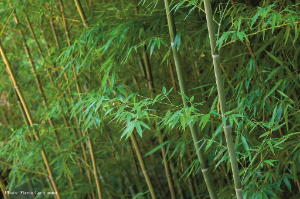 Giant Giant
- Phyllostachys viridiglaucescens: Bare stem reaching 10 cm in diameter, thick foliage. Has a height of 6-8 m.
- Phyllostachys Pubescens (Phyllostachys edulis): This is the classic giant bamboo through which the soldiers and heroes fly in epic Chinese films (House of Flying Daggers,Crouching Tiger, Hidden Dragon etc.). Growth is slower and has more difficulty than the others but, sooner or later, it turns into a real forest of large organ pipes.
- Phyllostachys viridis ‘Sulfurea’: A giant bamboo with stems of a delicate yellow with vertical stripes of different greens. It’s marvellous and seems to have stepped out of a Japanese painting.
Medium and Dwarf
- Phyllostachys bissetii: Has a slender stem and grows very densely; its bearing is erect but sinuous and it can reach about 5 m in height. It reproduces like mad. This is the bamboo used for the labyrinth.
- Hibanoubambusa tranquillans ‘Shiroshima’: Bushy bearing with large brilliant green leaves striped with yellow.
- Pleioblastus viridistriatus: medium-sized, bushy bearing; has large, light green leaves, slightly striped with golden green, that seem to be of velvet.
- Pleioblastus pumilus: a low, dense bamboo, replaces the lawn in shady areas. Cut with the lawn mower once or twice a year.
|
|
 |
 |
 |
 |
LOCATION |
 |
|
|
 |
|
 |
 |
 |

|
 |

|
Continent |
|
 |
|
Nation |
|
 |
|
Region |
|
 |
|
Province |
|
 |
|
Town |
|
 |
|
Place |
|
 |
|
Address |
|
 |
|
|
|
 |
|
Telephone |
|
 |
|
Website |
|
 |
|
E-mail |
|
 |
labirinto@francomariaricci.com |
|
 |
 |
 |
 |
MAP |
 |
|
|
 |
|
 |
 |
 |
| |
 |
|
 |
 |
 |
 |
|
TYPOLOGY |
 |
|
|
 |
|
 |
 |
 |
Main |
 |
|
 |
ARCHITECTURE | Buildings for cultural activities
Art galleries and exhibition areas
Buildings for offices and professional practises
Ateliers
|
LANDSCAPE ARCHITECTURE AND NATURAL ENVIRONMENTS | Landscape architecture
Theme parks
Land Art
| |
|
|
 |
|
Additional |
 |
|
 |
ARCHITECTURE | Commercial buildings
Bars, cafeterias
Restaurants
Religious buildings
Churches and places of worship
Buildings for means of information and communication
Newspaper and publishing house headquarters
| |
 |
 |
 |
 |
CHRONOLOGY |
 |
|
|
 |
|
 |
 |
 |
Project |
 |
|
 |
| 
 |
2005 - 2005
|
|
Realisation |
 |
|
 |
| 
 |
2010 - 2015 |
|
 |
 |
 |
 |
BIBILIOGRAPHIC REFERENCES |
 |
|
|
 |
|
 |
 |
 |
|
 |
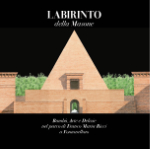 Franco M. Ricci, Vittorio Sgarbi, Corrado Mingardi, Giovanni Mariotti, Antonio Fernàndez Ferrer, Labirinto della Masone. Arte e Delizie nel parco di Franco Maria Ricci a Fontanellato, Ricci Editore, Fontanellato (Parma) 2014 Franco M. Ricci, Vittorio Sgarbi, Corrado Mingardi, Giovanni Mariotti, Antonio Fernàndez Ferrer, Labirinto della Masone. Arte e Delizie nel parco di Franco Maria Ricci a Fontanellato, Ricci Editore, Fontanellato (Parma) 2014 |
|
 |
 |
 |
 |
 |
 |
 |
EXHIBITIONS |
 |
|
|
 |
|
 |
 |
 |
| |
 |
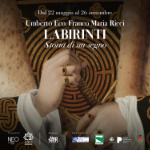 Umberto Eco, Franco Maria Ricci. Labirinti. Storia di un segno, Casalbarbato, Parma (Italy), Labirinto della Masone, 22 may 2021 / 20 march 2022 Umberto Eco, Franco Maria Ricci. Labirinti. Storia di un segno, Casalbarbato, Parma (Italy), Labirinto della Masone, 22 may 2021 / 20 march 2022 |
|
 |
 |
 |
 |
 |
 |
 |
CLIENT |
 |
|
|
 |
|
 |
 |
 |
| |
 |
|
 |
 |
 |
 |
STRUCTURES |
 |
|
|
 |
|
 |
 |
 |
| |
 |
Davide Cattani
Marco Pedrini |
|
 |
 |
 |
 |
LANDSCAPE DESIGN |
 |
|
|
 |
|
 |
 |
 |
| |
 |
|
 |
 |
 |
 |
STAFF |
 |
|
|
 |
|
 |
 |
 |
Project  |
 |
Franco Maria Ricci
Pier Carlo Bontempi |
|
|
 |
|
|
 |
|
Design concept |
 |
|
Architect |
 |
|
Botanical consultant |
 |
|
Systems |
 |
|
Lighting engineer |
 |
|
 |
 |
 |
 |
CREDITS |
 |
|
|
 |
|
 |
 |
 |
| |
 |
Photos © Mauro Davoli, Marco Campanini, Massimo Listri
Text edited by Fondazione Franco Maria Ricci
Courtesy of Labirinto della Masone
|
|
 |
  |
 |
|
|